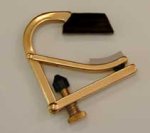Be it used as a fun novelty or to seriously explore alternate tunings, the Shubb Partial Capo is a nice little accessory that may open doors of new creative inspiration.
 Pros: Well made. Offers years of alternate tunings not possible with normal capos.
Pros: Well made. Offers years of alternate tunings not possible with normal capos.
Cons: Specialty item useful only for so much. No deluxe locking wheel version.
Bottom Line: A sturdy capo covering only three adjacent strings, it can take a guitarist a long way into new and unique chord voicings.
One of the most common acoustic guitar accessories is the capo. It presses a bar across all six strings, shortening the playable length of the neck, raising the tonal pitch of the strings. This all helps when wanting to play a song in a different key, without learning new chords. Shubb’s Partial Capo is another matter altogether. Because it does not depress all six strings, it opens the door to a whole new landscape of tonal possibilities.
Experimental Expressions
For some years professional guitarists like Adrian Legg, Chris Proctor and Harvey Reid had been taking Shubb capos and cutting notches into the rubber pad to allow the outer strings to remain at a lower pitch. So Shubb went ahead and produced the Partial Capo to attain the same effect.
Known at Shubb as the C7, this partial capo depresses just three strings. When put on in the normal fashion the capo’s rubber pad only comes into contact with the D, G and B string. Place it at the second fret and strums the open strings they will play an A Major chord. Move it to the 5th fret and a Cmaj9 is the result, or fret the E string at the 3rd fret to get a C major. Move the capo to other frets and much more unusual voicings begin to take shape.
Turn the Partial Capo upside down so that it is depresses the A, D and G string at the second fret provides an E suspended chord and a whole new set of sounds. In either case, moving the capo to various frets up the neck instantly provides different tonal pallets which can be harmonically pleasing or disturbingly dissident. In other words the Shubb Partial Capo brings about instant alternate tunings. All it takes is a little time and experimentation and the most rudimentary player is launched on a creative voyage of harmonic discovery.
Built to Last, with Instant Satisfaction
The Partial Capo is made in the same design as Shubb’s normal capos with sturdy, steel construction and rubber padding where it comes into contact with the guitar. Shubbs are among the few capos I find work well with V neck profile. I was happy that is comes in the attractive bronze color, which I prefer over the typical silver variety.
It is a snap to use, put it on and play. I found it highly entertaining just seeing what new combinations of chords and notes I could come up with when using as few fingers as possible. I then moved to more complicated voicings that at times had me applying fingers to fret positions above and below the capo. But the true potential of this capo did not come to the forefront until I took the guitar itself out of standard tuning.
Both DADGAD and CGDGAD tunings work very well with this capo. But I soon found myself starting with a typical alternate tuning, putting the capo at a fret position and then retuning one or two of the non-capoed strings to be in unison with one of the capoed ones, or an octave above or below it. At other times I would retune the non-capoed strings to provide a more perfect harmony in conjunction with the strings being fretted by the capo. I was amazed at how easy it was to find sublime and lush chords that rivaled the best things David Crosby or Michael Hedges ever came up with. It can also be used in conjunction with other standard or partial capos, to come up with even more exotic voicings.
The one drawback to the construction of this capo is that it uses the stationary post and rubber tip as the standard Shubb capo. I wish it has the wheel-based locking system of the Shubb Deluxe capo. The screw used in the standard version strips out over time, and the rubber nub does not always play nice with vintage V necks.
The Shubb Partial Capo may not be a required piece of equipment. A guitarist who spends their life in standard tuning my not find it of much use. But it is a lot of fun to experiment with and many guitarists will happily find it the key to discovering a whole new dimension in their playing and performance.
And that is one man’s word on…
The Shubb Partial Capo C7
Available at Maury’s Music
and other fine dealers